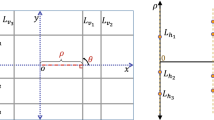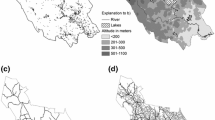Abstract
This paper derives the joint distribution of the distances to the first and the second nearest points for regular and random patterns. Distance is measured as the Euclidean and the rectilinear distances on a continuous plane. The joint distribution extends the kth nearest distance distribution of previous works. The kth nearest distance distribution only shows how the distance to the kth nearest point is distributed, whereas the joint distribution provides the relationship between the distances. An application of the joint distribution can be found in a facility location problem with non-closest facility service where the distance to the second nearest facility is also important. The joint distribution that allows us to examine the first and the second nearest distances simultaneously is useful for evaluating the reliability of facility location when some of the existing facilities are closed. The joint distribution of the road network distances is also obtained to confirm that the model on a continuous plane can be applied to actual road networks.










Similar content being viewed by others
References
Aras N, Orbay M, Altinel I (2008) Efficient heuristics for the rectilinear distance capacitated multi-facility Weber problem. J Oper Res Soc 59:64–79
Berman O, Krass D, Menezes M (2007) Facility reliability issues in network p-median problems: strategic centralization and co-location effects. Oper Res 55:332–350
Clark P, Evans F (1954) Distance to nearest neighbor as a measure of spatial relationships in populations. Ecology 35:85–90
Cressie N (1993) Statistics for spatial data. Wiley, New York
Dacey M (1968) Two-dimensional random point patterns: a review and an interpretation. Papers of the Regional Science Association 13:41–55
Daskin M (1983) A maximum expected covering location model: formulation, properties and heuristic solution. Transportation Sci 17:48–70
Drezner Z (1987) Heuristic solution methods for two location problems with unreliable facilities. J Oper Res Soc 38:509–514
Francis R, McGinnes F, White J (1992) Facility layout and location: an analytical approach. Prentice Hall, Upper Saddle River
Getis A (1983) Second-order analysis of point patterns: the case of chicago as a multi-center urban region. Prof Geogr 35:73–80
He F, Duncan R (2000) Density-dependent effects on tree survival in an old-growth douglas fir forest. J Ecol 88:676–688
Holgate P (1965a) The distance from a random point to the nearest point of a closely packed lattice. Biometrika 52:261–263
Holgate P (1965b) Some new tests of randomness. J Ecol 53:261–266
Illian J, Penttinen A, Stoyan H, Stoyan D (2008) Statistical analysis and modeling of spatial point patterns. Wiley, Chichester
Jones A, Langford I, Bentham G (1996) The application of K-function analysis to the geographical distribution of road traffic accident outcomes in Norfolk, England. Soc Sci Med 42:879–885
Koshizuka T (1985) On the relation between the density of urban facilities and the distance to the nearest facility from a point in a given area. J City Plann Inst Jpn 20:85–90. (in Japanese)
Krause E (1987) Taxicab geometry: an adventure in non-euclidean geometry. Dover, New York
Larson R (1974) A hypercube queuing model for facility location and redistricting in urban emergency services. Comput Oper Res 1:67–95
Larson R (1975) Approximating the performance of urban emergency service systems. Oper Res 23:845–868
Larson R, Odoni A (1981) Urban operations research. Prentice-Hall, Englewood Cliffs
Lee S (2001) On solving unreliable planar location problems. Comput Oper Res 28:329–344
Marianov V, ReVelle C (1994) The queueing probabilistic location set covering problem and some extensions. Socio-Econ Plann Sci 28:167–178
Marianov V, ReVelle C (1996) The queueing maximal availability location problem: a model for the siting of emergency vehicles. Eur J Oper Res 93:110–120
Miyagawa M (2008) Analysis of facility location using ordered rectilinear distance in regular point patterns. FORMA 23:89–95
Miyagawa M (2009a) Order distance in regular point patterns. Geogr Anal 41:252–262
Miyagawa M (2009b) Rectilinear distance in rotated regular point patterns. FORMA 24:111–116
Murray A, O’Kelly M (2002) Assessing representation error in point-based coverage modeling. J Geogr Syst 4:171–191
Okabe A, Yamada I (2001) The K-function method on a network and its computational implementation. Geogr Anal 33:271–290
Okabe A, Yomono H, Kitamura M (1995) Statistical analysis of the distribution of points on a network. Geogr Anal 27:152–175
Okabe A, Boots B, Sugihara K, Chiu S (2000) Spatial tessellations: concepts and applications of voronoi diagrams. Wiley, Chichester
O’Kelly M (2009) Rectilinear minimax hub location problems. J Geogr Syst 11:227–241
Persson O (1964) Distance methods: the use of distance measurements in the estimation of seedling density and open space frequency. Studia Forestalia Suecica 15:1–68
Pielou E (1959) The use of point-to-plant distances in the study of the pattern of plant populations. J Ecol 47:607–613
Pirkul H (1989) The uncapacitated facility location problem with primary and secondary facility requirements. IIE Trans 21:337–348
ReVelle C, Hogan K (1989) The maximum availability location problem. Transportation Sci 23:192–200
Ripley B (1976) The second-order analysis of stationary point processes. J Appl Probab 13:255–266
Skellam J (1952) Studies in statistical ecology: spatial pattern. Biometrika 39:346–362
Snyder L (2006) Facility location under uncertainty: a review. IIE Trans 38:537–554
Snyder L, Daskin M (2005) Reliability models for facility location: the expected failure cost case. Transportation Sci 39:400–416
Sorensen P, Church R (2010) Integrating expected coverage and local reliability for emergency medical services location problems. Socio-Econ Plann Sci 44:8–18
Thompson H (1956) Distribution of distance to nth neighbour in a population of randomly distributed individuals. Ecology 37:391–394
Vaughan R (1987) Urban spatial traffic patterns. Pion, London
Weaver J, Church R (1985) A median location model with nonclosest facility service. Transportation Sci 19:58–74
Yamada I, Thill J (2004) Comparison of planar and network K-functions in traffic accident analysis. J Transport Geogr 12:149–158
Acknowledgments
This work was supported by Grant-in-Aid for Young Scientists (B) (22710140). I wish to thank three anonymous reviewers and the editor for their helpful comments.
Author information
Authors and Affiliations
Corresponding author
Rights and permissions
About this article
Cite this article
Miyagawa, M. Joint distribution of distances to the first and the second nearest facilities. J Geogr Syst 14, 209–222 (2012). https://doi.org/10.1007/s10109-010-0143-3
Received:
Accepted:
Published:
Issue Date:
DOI: https://doi.org/10.1007/s10109-010-0143-3




